What affects female happiness at home on flower transplantation?
Season
You can transplant "female happiness" at any time of the year, the main thing is that the air temperature in the room is above +20 degrees. However, the best period for transplanting spathiphyllum is considered the end of winter - the beginning of spring, when the exotic begins to awaken after a period of rest.
Experienced flower growers advise replanting spathiphyllum at the same time, for example, in March or April. So it will be easier for the plant to take root in the new soil, and it will bloom in time.
Sometimes an urgent need to renew the soil of a flower arises in winter, for example, in December, then the owner does not need to think about whether this can be done, but to make sure that during the procedure the roots of the exotic are not frostbitten and transplant. Before starting it, you should heat the air in the room to 20-22 degrees with heating devices and install a humidifier.
Plant age
When choosing the optimal transplant schedule, it is recommended to pay attention to the age of the flower. Spathiphyllum up to 3 years old is considered young, as it is actively gaining growth
During this period, it is advisable to transplant it into a larger pot at least 1 time per year so that the plant is not cramped. From 3 years or more, the flower is considered mature, and its growth slows down. Therefore, it is necessary to transplant it less often.
Spathiphyllum up to 3 years old is considered young, as it is actively gaining growth. During this period, it is advisable to transplant it into a larger pot at least once a year, so that the plant is not crowded. From 3 years or more, the flower is considered mature, and its growth slows down. Therefore, it is necessary to transplant it less often.
State of culture
The poor condition of the flower or the appearance of pests on it is a reason to transplant it as soon as possible. If you do not provide help to the plant in a timely manner, then it may soon wither away. Signs of a poor state of spathiphyllum:
- leaves become less elastic;
- the appearance of brown or yellow spots on the leaves;
- blackening of the corners of the leaves;
- the appearance of rotten areas on leaves and stems.
If at least one of the above signs is observed in spathiphyllum, then it is necessary to carefully remove it from the pot and check the condition of the roots. The presence of rotten and damaged areas on the roots suggests that the flower needs to be transplanted as soon as possible.
In this case, before transplanting, it will be necessary to put the plant in order by cutting off the affected leaves, stems and roots with a sterile knife.
But sometimes, after transplanting, similar problems arise with the plant. Read about why the spathiphyllum after transplanting dropped its leaves, turned black or yellowed, wilted, read here.
Reproduction and transplantation of spathiphyllum
Spathiphyllum propagates both by seeds and vegetatively using cuttings and pieces of rhizomes.
Seed propagation
quite troublesome, you need to carry out artificial pollination. Seeds quickly lose their germination. Most commonly used
reproduction by pieces of rhizomes and cuttings
, the plants take root well. This feature of plants is used when such an operation is performed as transplantation of spathiphyllum.
It all starts with preparing the potting mix. For spathiphyllums, you can use ordinary humus, to which brick chips and pieces of charcoal are added. You can prepare a special soil mixture for aroids from humus, whole leaf soil, peat and sand (1: 1: 1: 0.5).
Crushed coal, pieces of bark and brick chips are also added to this mixture. The prepared soil mixture is spilled with a hot, strong solution of potassium permanganate for the purpose of disinfection.
The acidity of the soil should be slightly acidic from 5 to 6.5, but not neutral. Then the spathiphyllum transplant will not cause trouble in the form of various diseases.
When to transplant spathiphyllum
As the flower grows, the roots fill the pot completely, and it becomes cramped for the plant, the plant is transferred to a larger pot. This is best done in the spring. Spathiphyllum is most often purchased in the store. Two to three weeks after purchase, spathiphyllum is required to be transplanted into a more spacious container.
Spathiphyllum must be handled very carefully during transplantation. Transplanting spathiphyllum, like any flower culture, begins with good watering. If the pot is small, it is enough to cover the ground with your palm, press the plant with your fingers and turn the pot over and lightly tap the pot on the edge of the table.
The earth ball should completely move away from the walls of the flower pot.
A lump with intertwined roots is slightly loosened with a wooden peg, removing some of the earth on the sides, top and bottom. If there are damaged or blackened roots, cut with a knife. The place of the cut is sprinkled with crushed coal. Spathiphyllum at home.
Consider how the spathiphyllum transplant itself is carried out
At the bottom of the pot we pour a little vermiculite as drainage and so much soil so that the plant placed in the pot is two centimeters below its edge. Gradually fill the pot along the edges, lightly crushing the potting mix. Care must be taken not to leave a void. If a support is required, we also install it during transplantation. It is rather not the transplantation of the spathiphyllum that is carried out, but its transshipment.
The resulting new roots with a lack of moisture will move and spread better in search of moisture. If you water the plant less often during this period, the transplant of spathiphyllum will be more successful. This will help the roots damaged during transplantation to avoid decay. When new shoots appear, the usual watering regime is resumed.
Spathiphyllum transplant. Is it possible to divide rhizomes
Often in the spring, for the reproduction of spathiphyllum, a method of dividing rhizomes is used
The overgrown flower is carefully removed from the pot, the rhizomes are cut into fragments, each of which should have a growing point and a piece of rhizome, which should bear 2-3 leaves
Planting material is planted in low pots in a ready-made substrate for aroids. If you cover the transplanted plants with glass jars, a special microclimate is created. Such a transplant of spathiphyllum contributes to better plant survival.
If the pot is large enough, the plant has enough room in it, you can gently loosen the top of the earth with a wooden peg and replace part of the soil.
Transplanting spathiphyllum requires careful and careful handling of the plant. Subject to all the rules, the transplantation of spathiphyllum will end with a good survival rate of plants, which will delight you with their beautiful white flowers for a long time.
How to transplant a flower at home Women's happiness
Spathiphyllum is a beautiful flower that perfectly complements any interior. In order for it to bloom and grow for a long time, you need to know how to transplant "Women's Happiness" at home.
Why and how often do you need a transplant?
After the purchase, most novice growers are in a hurry to transplant the plant, in fact, this is not the best idea, because during this period it experiences stress due to changes in conditions. The flower needs to acclimatize before putting a new load on it.
If we talk about the frequency of changing the container, then the first transplant after the purchase should be carried out only after a few months, and some professionals advise even no earlier than a year later. Young bushes then have to move to new containers every year, since their root system is in a phase of active continuous growth. If there is not enough space, then the flower will begin to feel bad, the roots will begin to appear outside the soil, penetrate into the drainage holes.
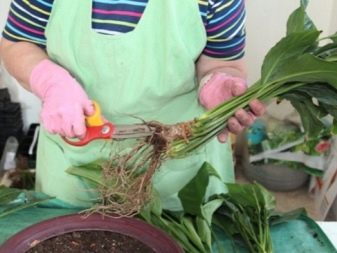

But this is not the only reason why a pot change may be required, since the soil is also replaced with it. For a year and even for 3 years, the earth is saturated with salts, it becomes bad, so it needs to be changed. Changing the container is the perfect solution. The new soil is laid well-drained, disinfected and filled with minerals necessary for the growth and development of the flower.
It also happens that suddenly a plant is attacked by a nematode or root rot. This is a reason to urgently replace not only the soil and container, but also cut the roots to enable the spathiphyllum to survive. The container will need to be disinfected if you plan to use it again in the future. In this case, the roots must be washed, removing all the old soil, treated with an insecticide or fungicide, depending on the problem.

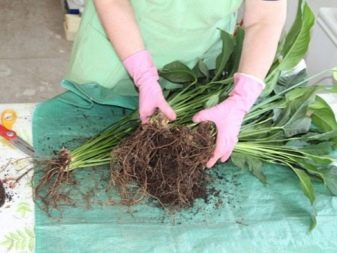
How to transplant spathiphyllum after purchase?
The transplant of the spathiphyllum purchased in the store is carried out not immediately, but after 2-3 weeks, after the flower has adapted to new conditions. After making sure that the plant has a healthy appearance, it is moved to a new, slightly larger container with a complete replacement of soil.
The need for transplanting after purchase is due to the peculiarities of the composition and structure of the soil used to grow the plants for sale.
- Spathiphyllum is grown on peat soil. The flower grows rapidly, consuming all nutrients and rapidly depleting the soil, which will inevitably affect its development.
- Peat soils have a dense structure, preventing the flow of air and water to the roots. Saturated with moisture, peat retains it for a long time, provoking the development of rot on the roots of the plant.
How often should the procedure be carried out?
The frequency of transplants is determined by the age of the flower:
- young (up to 3 years old) specimens are transplanted annually;
- adult forms - once every 3-5 years.
Which pot?

Spathiphyllum grows well in pots made from any material. According to this criterion, the choice of capacity depends only on the personal preferences of the grower or his material capabilities. The size of the container is selected taking into account the volume of the root system of the flower and the characteristics of its growth. Since the roots of spathiphyllum grow more actively in the horizontal direction, the diameter of the pot should exceed its depth.
At each transplant, a container is used that is slightly larger (by 1-2 cm) than the previous one.
This is essential for root development. Only having fully mastered the entire volume provided to the roots, the plant begins to actively grow leaves and bloom
Reference! Experienced growers recommend planting young plants in containers with a diameter of no more than 10 cm. The maximum container size for an adult and large plant should not exceed 18-20 cm.
The pot should have a large drainage compartment and drain holes.
What kind of soil?

Loose soils with a neutral or slightly acidic environment are suitable for growing a flower. Soil that meets these requirements can be purchased at a flower shop. You can prepare the earthy mixture yourself. This will require:
- 2 parts of sod land;
- 1 piece of leafy land;
- 1 part sand;
- 1 part peat.
- ½ part of ceramic chips, charcoal and bark.
Ceramic chips, coal and bark are added to give the soil air and water permeability and the required level of acidity.
All components are thoroughly mixed. The soil, regardless of the method of its production, is disinfected. This will avoid the occurrence of diseases.
Disinfection is carried out in any available way:
- for 30 minutes, steamed in a water bath;
- 15-20 minutes are calcined in an oven or microwave;
- spill with a solution of potassium permanganate of medium (pink color) concentration or a solution of phytosporin;
- 2 weeks before planting, to restore useful microflora, the soil is moistened by adding EM-1 to the water.
Correctly selected and processed soil mixture will ensure good development and, as a result, decorative effect of spathiphyllum.
Pot and soil selection
For spathiphyllum, the material from which the container is made does not matter, where it will grow and develop
It is worth paying attention only to the fact that in clay soil salinization occurs faster, but it also dries out after watering at a high speed. When choosing a container, you can rely on your own budget
The containers made of clay are the most beautiful, but they are also fragile. If such a pot falls, it will surely break. In comparison with them, plastic ones last longer, cost less, and are presented on the market in a wide variety.
As for the volume of the new container, it should be only a few centimeters wider in diameter. The described flower has a peculiarity - the closer to the roots, the better it blooms, respectively, too much space in the soil will lead to the fact that flowers cannot be expected. Soil that drains well while remaining moist is best for spathiphyllum. The required amount of moisture in it helps to keep the leaves glossy green. This flower will not live in damp earth.
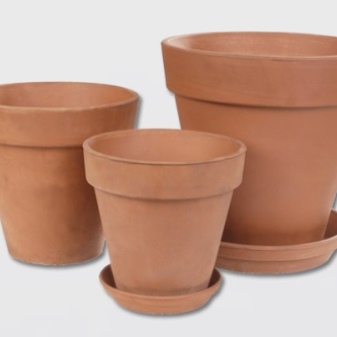
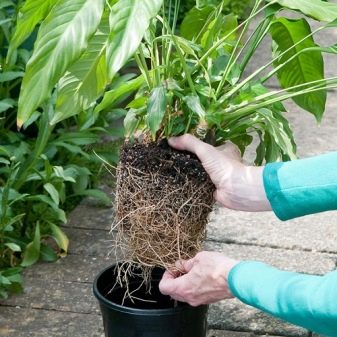
Water fills in the gaps in the soil that normally contain air, which allows the roots to breathe. When there is too much moisture, the leaves turn brown and wither. To make high-quality soil, it is recommended to mix one part of loam with the same amount of peat moss and sand. With all this, river sand is not suitable for a houseplant, it contains many substances harmful to it, so it is better to purchase purified one. The composition of another compost mixture suggests mixing peat with perlite and bark chips.
Store-bought supplies are usually sterilized. If you decide to use soil from your home compost heap instead of a piece of peat moss, it will also need to be sterilized. This is done very simply, you need to put the earth in the oven for an hour and heat it to a maximum temperature of 80 C. If you overheat, then all the benefits of such soil will go away, since minerals and vitamins are destroyed.

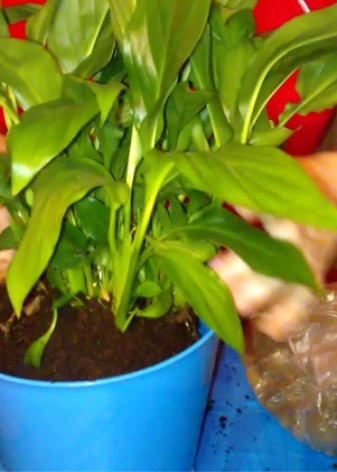
Like any tropical plant, spathiphyllum is used to getting a lot of nutrients from the soil. That is why you will need to feed regularly, but it is worth starting a month after transplanting. Water-soluble balanced fertilizers with the formula 20-20-20 are used to replenish nutrients. Strong concentration can burn the plant, so dilute the product to about 25 percent of the recommended amount on the package before adding it to the soil. Dry dressings are applied exclusively to wet soil.
Over time, the plant tends to leach nutrients from the soil, and fertilization may not always make up for what is lost. This leads to a build-up of salt or other harmful chemicals that are harmful. It is for this that a complete soil replacement is performed every few years, as a rule, together with a transplant.


Further care
Immediately after the procedure, it is required to spray with a spray bottle. During the first two to four weeks after transplanting, you need to create high humidity conditions for the plant. The aerial part of the spathiphyllum must be placed in a mini-greenhouse. To do this, put a plastic bag on the plant. Remove such a cap only for the purpose of airing, as well as before watering and spraying.
Watering
Moistening the soil is required as the top layer dries. For watering, use settled water at room temperature. Be sure to drain excess liquid from the pan. Showering once a week is helpful if the bathroom is warm. In winter, the abundance and frequency of watering and bathing should be reduced.
Attention! Water stagnation should not be allowed. Prolonged waterlogging of the soil can lead to root rot and death of spathiphyllum.
Air humidity
In the room where the flower is located, it is necessary to maintain a constant air humidity at the level of 60-70%. After transplanting, it is recommended to spray the plant in the morning and evening.
With wilting and yellowing of the leaves, it is required to increase the number of sprays up to three times a day. Then, after improving the condition of the plant, once will be enough. If the air in the room is not humid enough, you can place containers with water next to the plant.
Location selection and lighting
The plant thrives on north, west or east windows. For spathiphyllum, you should choose a place away from heating appliances - dry air harms the plant.
A dim, diffused light is required. In the summer, you need to shade the plant or clean it deep into the room. In winter, put on the windowsill.
Spathiphyllum does not tolerate direct exposure to bright sunlight. This can lead to burns and wilting of leaves, as well as stunted growth.
Temperature
The optimal temperature regime for a plant is from +22 to +25 ° C during the warm period. In winter, the indicators should be in the range from +18 to +20 ° C and not fall below +16 ° C
It is important to avoid drafts and hypothermia
In winter, you cannot often arrange a shower for a flower, otherwise problems with the roots will arise and the leaves will begin to turn black.
Top dressing
Liquid fertilizers are suitable for flowering indoor plants. Such dressings should be applied from spring to autumn, every seven to ten days, after watering. It is not recommended to use fertilizers in granules. In winter, spathiphyllum does not need to be fed - the plant is in the dormant stage.
Post-flowering care
With good content, spathiphyllum blooms from spring to autumn. After the flowering period, it is necessary to cut off the dried flower. You should also reduce the frequency of watering.
Attention! With proper maintenance, spathiphyllum actively grows, it needs an annual transplant. It is better to do this in spring time, between flowering periods .. About what time it is better to transplant spathiphyllum, read here
Read about the best time to transplant spathiphyllum here.
So, we looked at when and how spathiphyllum is transplanted after purchase
It is important to carry out this procedure carefully and carefully. Then arrange the right care according to the needs of the plant. Provide adequate moisture, keep spathiphyllum warm, protect from bright light and feed in a timely manner
Provide sufficient moisture, keep spathiphyllum warm, protect from bright light and feed in a timely manner.
Selection rules
When planting a large spathiphyllum bush or transferring a purchased plant into a new container, pay attention to the choice of a pot and soil recommended for indoor culture
Pot
When choosing which pot is needed for spathiphyllum, the size of the previous one is determined. The plant is planted in a container, which exceeds the former container by 1.5-2 cm in width and height. Florists noticed that spathiphyllum blooms profusely when the roots cover the entire substrate.
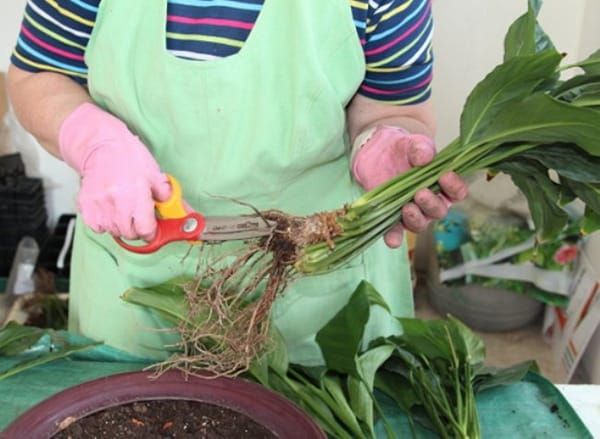
Pruning
In a pot that is too spacious, the bush will grow the root system and only then discard the peduncles. Containers with holes in the bottom are suitable, through which excess water flows into the pan after watering. As with any indoor plant, a drainage of 1-2 cm is required for spathiphyllum.
Soil
Spathiphyllum develops well in a weakly acidic substrate, pH 5-6.5, loose and light in structure. In such potting mixes, excess moisture seeps into the sump. In the trade network, they choose a universal mixture for aroid or tropical flowering plants, which is mixed with a handful of sand. Many growers prepare the substrate on their own. You can choose a suitable one, usually the simplest in execution, from several options:
- 3 parts of peat, 2 parts of leafy soil, 1 part each of humus, sand and bone meal;
- 1 part of leafy soil, peat, humus, sand, 2 parts of sod land;
- 1 part of leafy soil and peat, half of soddy soil and sand.
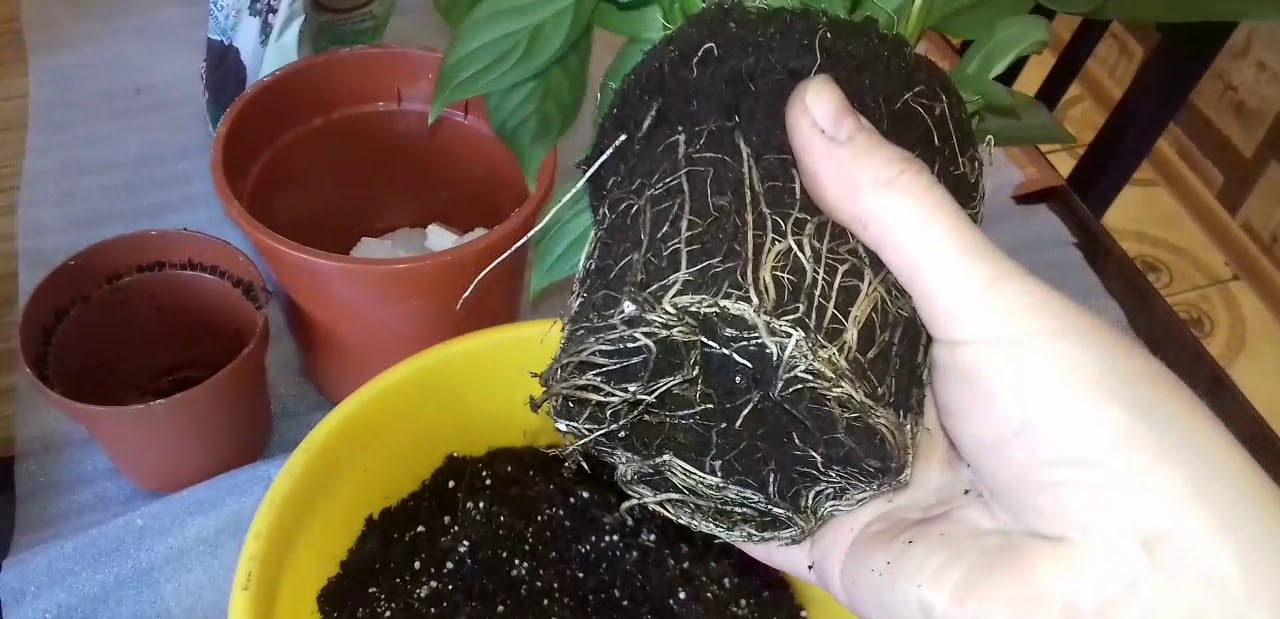
Pot
Horse peat is used. Wood bark, coconut fiber, charcoal and brick chips are also added to the substrate for looseness. Additives make up no more than 10% of the total mass. They also put sphagnum moss, which protects the soil mixture from drying out.
When transplanting, fertilizer is added - 0.5 teaspoon of superphosphate. If the substrate is prepared independently, the earth is spilled with a dark pink hot solution of potassium permanganate.
Fertilizers
For good flowering, spathiphyllum is regularly maintained with top dressing, otherwise a beautiful green bush will grow, but without the original white covers with flower cobs. Or the stalks will be thrown out for a short time and at long intervals.
It is especially important to feed the plant in the spring-summer period, when all processes are activated: once every 10-16 days
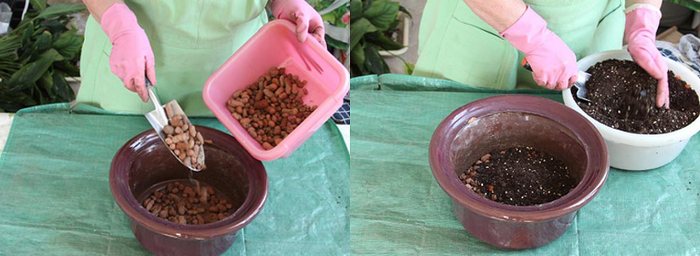
Priming
In winter, when the dormant period begins in the room culture, the substrate is fertilized once every 30 days. Spathiphyllum responds well to organic fertilizers available in stores, especially poultry droppings. Any universal preparations for flowering indoor plants are also suitable: "Flower", "Azalea" and others.
If no fertilization was applied at the end of February or in March, the spathiphyllum ends blooming in June, and the flower stalks do not form again. At the same time, too many nitrogen preparations should not be given, since the green mass will grow, but not the buds.
Note! Florists noticed that the appearance of brown spots on the leaf blades is evidence of an excess of nutrients. Housewives often pour the "female happiness" with chilled liquid after boiling pasta or potatoes, used from the aquarium with water
In late autumn and winter periods, when the intensity of natural lighting decreases, the humic fertilizer "Universal plant balm" is used for spathiphyllum. The drug stimulates culture and helps to cope with the lack of light
Housewives often pour the "female happiness" with chilled liquid after boiling pasta or potatoes, used from the aquarium with water. In late autumn and winter periods, when the intensity of natural lighting decreases, the humic fertilizer "Universal plant balm" is used for spathiphyllum. The drug stimulates culture and helps to cope with the lack of light.
When and how to properly transplant spathiphyllum
Transplant timing
Usually, the time of the onset of transplantation can be determined by the appearance and volume of the flower. At this point, it takes up most of the flower container. A transplant is necessary even when the plant continues to grow and bloom, because the overgrown root part continues to give the flower its last strength. But it is still most favorable to replant plants in early spring and always in between flowering periods. It is not recommended to disturb the flowering plant, as all the beauty will quickly fade.
It is recommended to transplant the flower for the first time about 15-20 days after purchase. Spathiphyllum needs a spacious container. After each transplant, the size of the flower container should be selected one larger than the previous one.
Selection of soil mixture
Potting soil can be prepared at home. For cooking, you will need: coarse sand, leafy soil and peat - one part at a time, sod land - two parts, small chips of broken brick and wood ash - half a part.
Among the wide variety of commercial mixtures, it is better to opt for a soil mixture for plants of the Aroid family. These plants include spathiphyllum and light loose soil is ideal for it.
It is worth paying attention to the level of acidity of the substrate, it should be slightly acidic.This soil mixture will make the living of tropical spathiphyllum at home comfortable and favorable.
Transplant rules
It is very important not to damage the root part of the plant during transplantation, since it is very fragile and vulnerable in spathiphyllum. That is why it is best to use the method of transshipment of an earthen coma along with a plant.
Before the procedure, the flower must be watered abundantly so that the moist soil, along with the plant, can easily separate from the flower pot. If the overgrown root system has wrapped around the drainage, it must be removed from the plant. It is also necessary to carefully examine the condition of the root part and, in the presence of damaged and diseased parts, it is advisable to remove them. It is recommended for such plants to treat the root system with special preparations for prevention and full further development.
Before planting a plant in a new container, you need to free it from dried old leaves and cut off the children. Young shoots of a flower (babies) are an ideal planting material and an excellent way to propagate it. A mature plant will only benefit from such removal.
The container after transplantation should be one size larger, its bottom should be filled with a small layer of drainage. You can use for this large river or sea pebbles, broken brick or expanded clay. After the drainage layer, it is necessary to pour the substrate up to half the pot, put the plant, straighten all the roots and add soil to the top. The soil must be compacted a little and watered abundantly. If necessary, the soil can be filled up after settling so that the flower sits tightly in it.
Spathiphyllum care immediately after transplant
After transplanting, you must immediately go to "water procedures" - this is watering and spraying. After abundant watering, you will have to drain the water from the pan after a while. Spraying is carried out using a spray bottle or other spray. The moisture will ease the stressful transplant procedure for the houseplant and help it settle down in its new location.
Secrets of proper care in the first month after transplant
To shorten the process of acclimatization of spathiphyllum after transplantation, you will need a mini-greenhouse. It will provide the plant with the right amount of moisture in the first few weeks, which will significantly bring the onset of flowering. The entire aerial part of the indoor flower must be placed in an ordinary plastic bag, putting it on top of the spathiphyllum. Such a cover will only need to be removed for airing and watering and spraying. It is recommended to maintain such care for at least the first two weeks.
Lack of moisture can lead to yellowing and wilting of the leafy part. If negative signs appear, it is worth increasing the number of spraying up to 2-3 times a day, and watering should be carried out only after the top layer of the soil has dried by about 5-10 millimeters.
The decorative qualities and the unique flowering of spathiphyllum will be at the highest level only if all recommendations for the care and maintenance of the plant are followed, as well as if the timing and methods of transplantation are observed.


